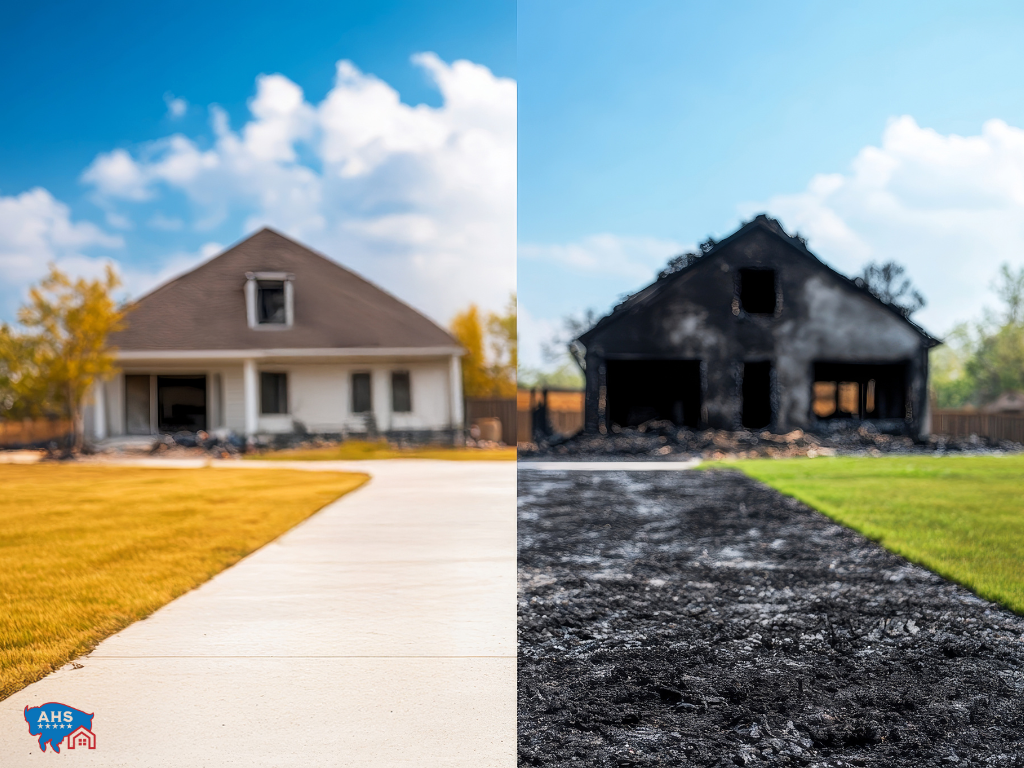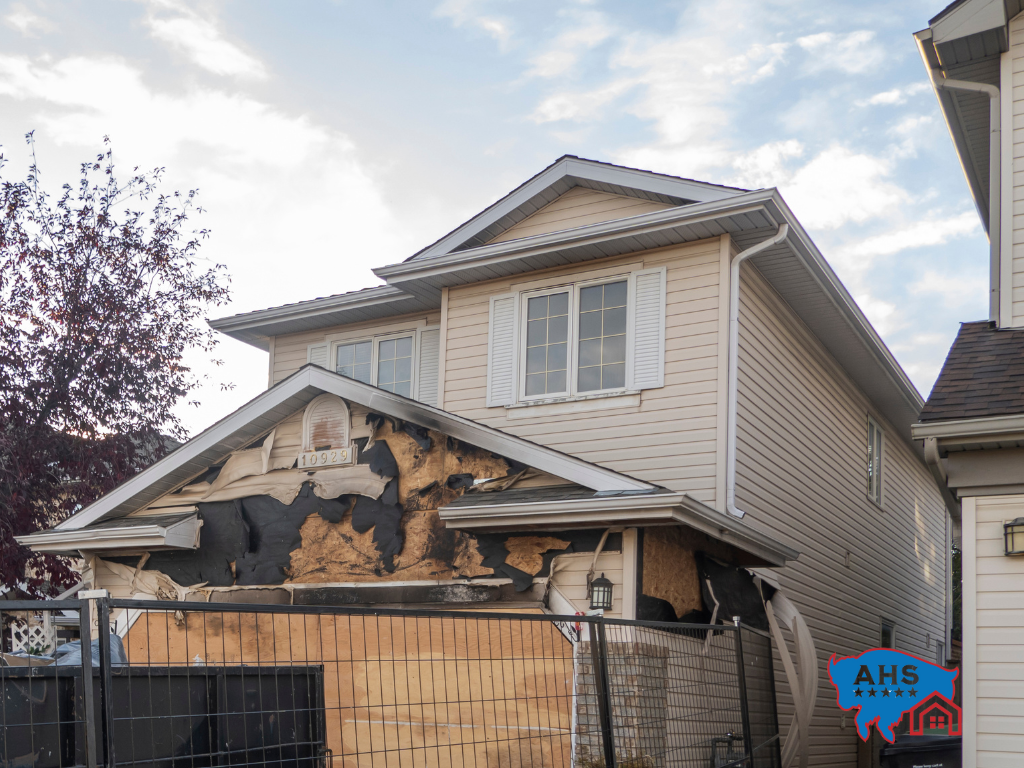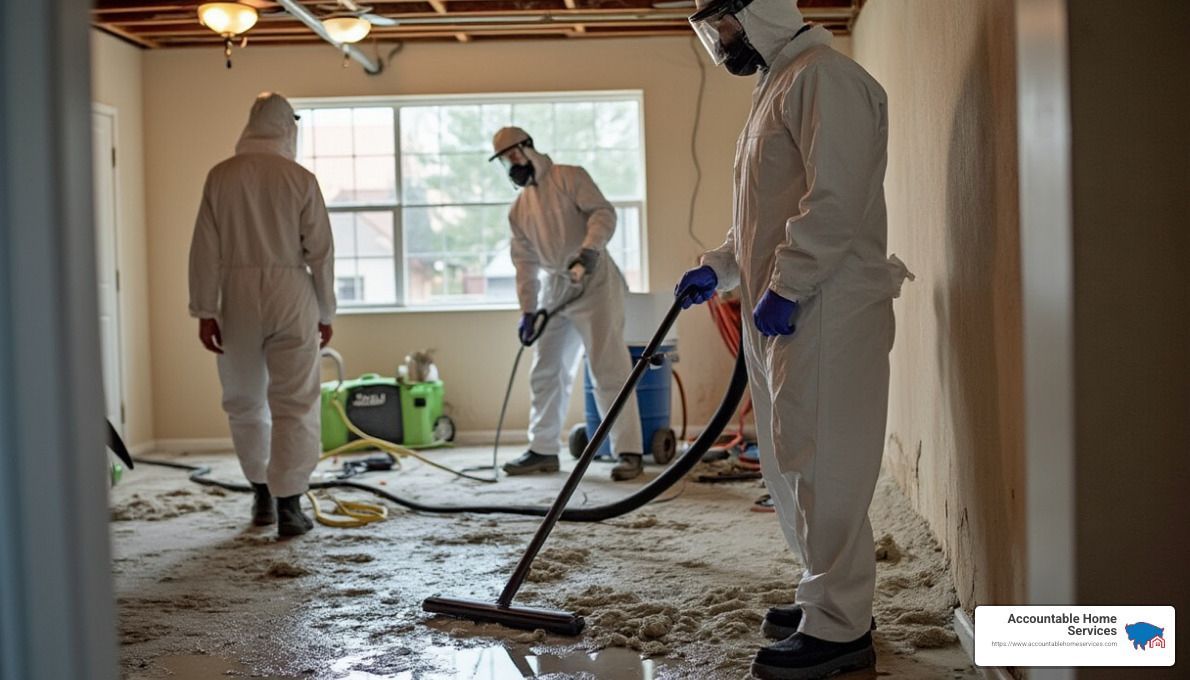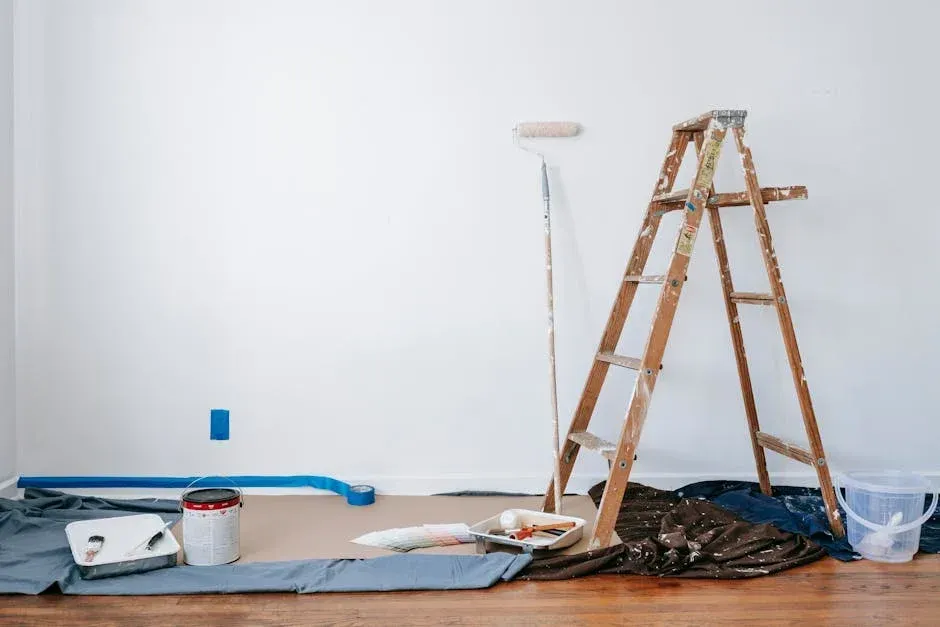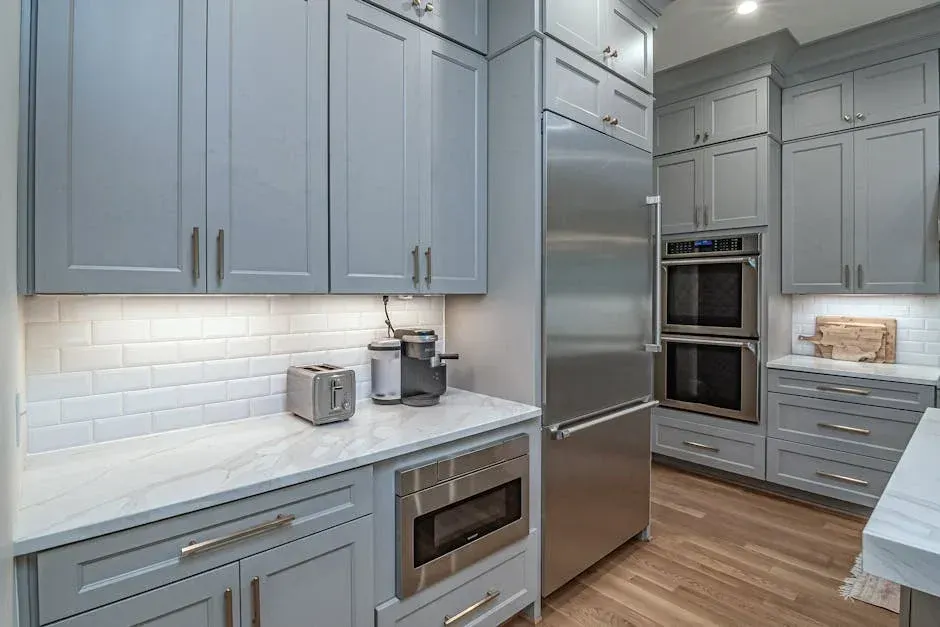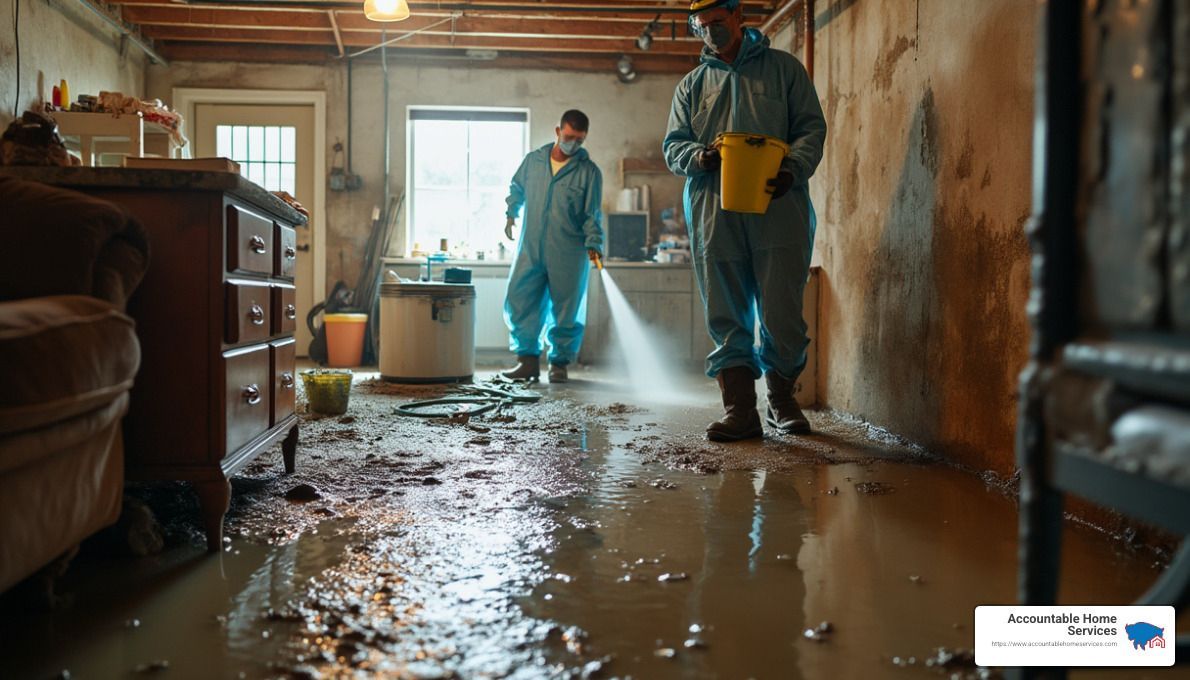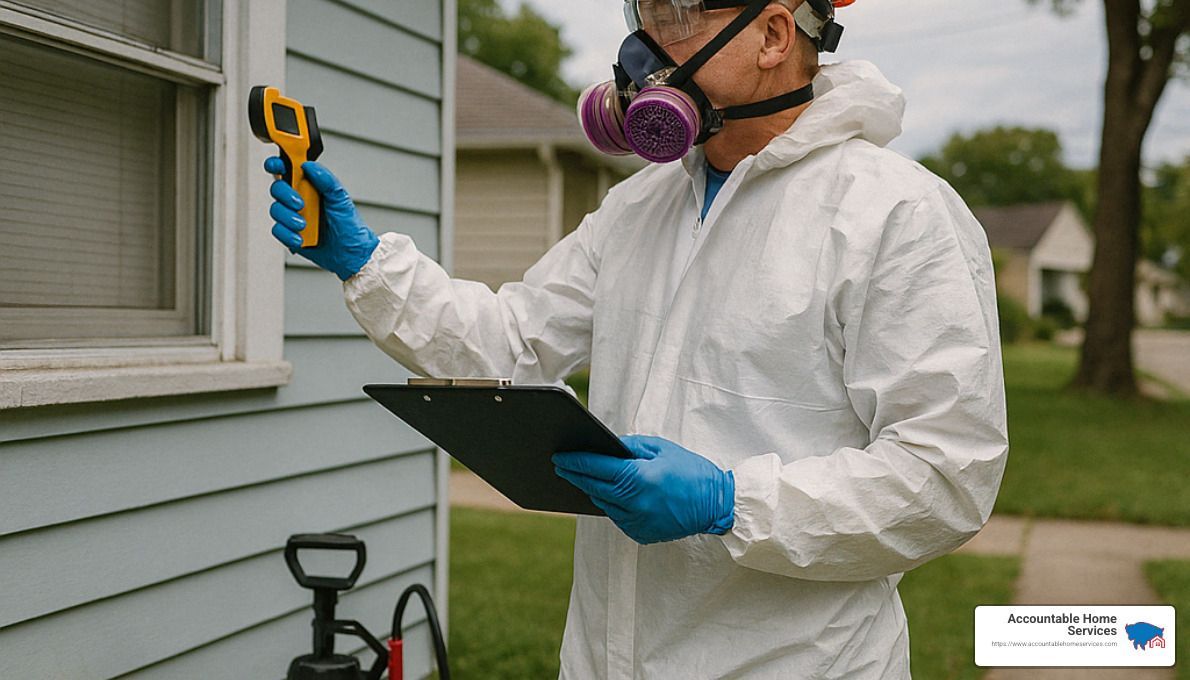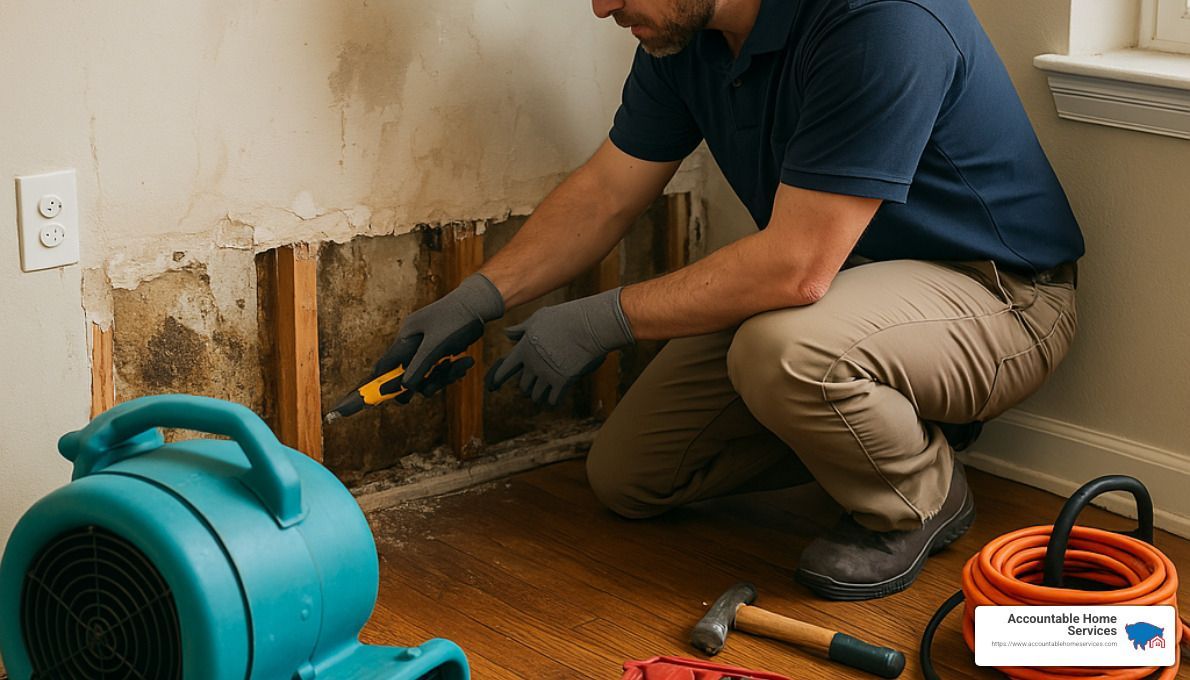Blog
Basement home theater setup is an appealing project for many homeowners looking to improve their living space. To get started:
- Declutter and prepare your basement. Assess your existing space and remove any stored items.
- Ensure proper insulation and soundproofing by consulting with a contractor.
- Upgrade or verify your electrical systems to handle audiovisual equipment.
- Decide on the audiovisual setup, including screen type and projector specs.
- Optimize seating arrangements for the best viewing experience.
Welcome to Accountable Home Services! I'm Mike Martinez, your guide to turning your basement into a cinematic oasis. With years of experience in basement home theater setup, I'm here to help you steer the journey from a simple storage space to a remarkable entertainment zone.
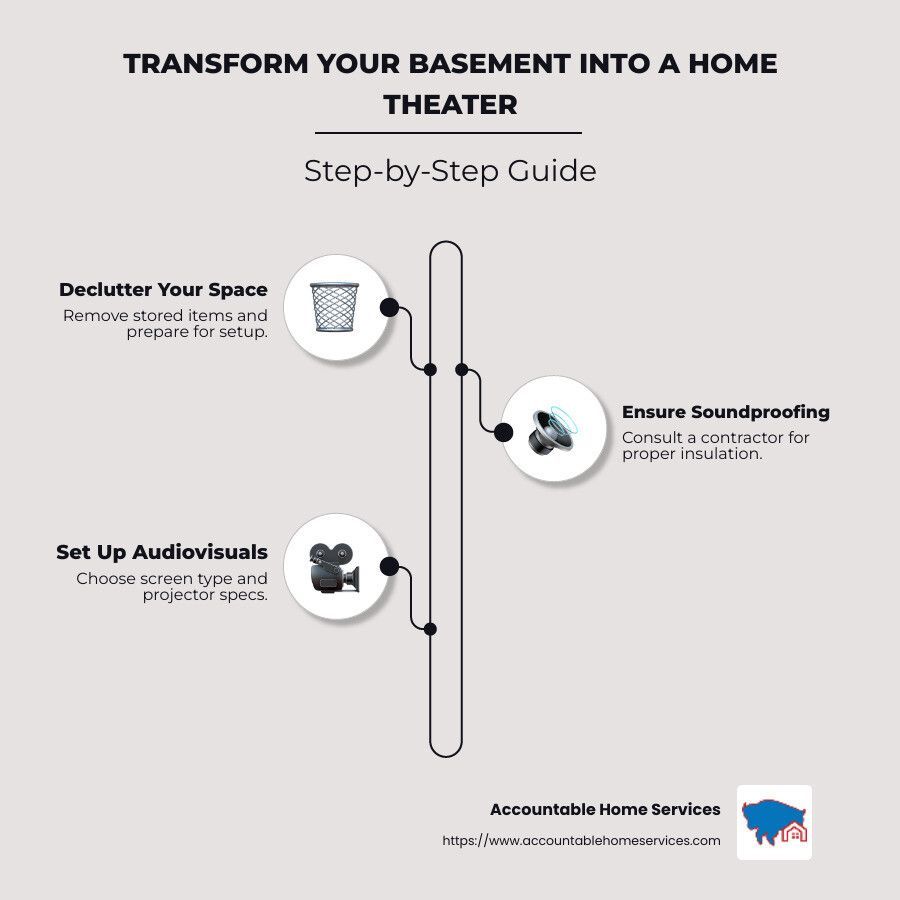
Planning Your Basement Home Theater Setup
Changing your basement into a home theater is an exciting project, but it requires careful planning. Let's break it down into key steps to ensure your basement home theater setup is both functional and enjoyable.
Declutter and Prepare Your Basement
Before diving into the technical aspects, start by decluttering. Basements often serve as catch-all storage spaces. Relocate items to other storage areas or consider renting a storage unit if necessary. This step not only frees up space but also helps you visualize the potential of your basement.
Finish Your Basement
Once decluttered, it's time to finish the basement. This involves adding insulation and soundproofing. Basements are naturally isolated from outside noise, but adding thermal and acoustical fiberglass insulation can further improve sound quality and temperature control. Covering walls with acoustic drywall panels can provide superior sound damping and moisture protection.
Ensure to consult with a contractor to verify that your existing central heating and electrical systems can support the additional load of a home theater setup.
Optimize Seating Arrangement
A well-thought-out seating arrangement is crucial for an optimal viewing experience. Consider the number of people you want to accommodate and choose seating that fits your needs. Custom home theater seats with features like cup holders and USB chargers can lift the experience.
To determine the best distance between the screen and seats, multiply the horizontal length of your screen by 2 for the minimum viewing distance and by 5 for the maximum. Maintain at least four feet between viewers’ heads and the walls or surround speakers.
Focus on Acoustics
Acoustics play a pivotal role in creating an immersive experience. The placement of your speakers depends on your sound system. For a 5.1 surround sound system, place three speakers and a woofer in front, with two speakers slightly behind the seating area. If you opt for a 7.1 system, place the additional speakers directly behind the audience.
Incorporating in-wall or ceiling-mounted speakers can help maintain a clean look while ensuring high-quality sound. Acoustic wall panels can further improve sound quality by reducing echoes and reverberations.
With these steps, you're well on your way to creating the perfect basement theater setup. Next, we'll dig into the essential equipment you'll need to bring your home theater to life.
Essential Equipment for a Basement Home Theater
Creating a basement home theater setup that rivals a commercial cinema is within your reach with the right equipment. Here's what you need to focus on:
Projector
The centerpiece of any home theater is the projector. When selecting a projector, consider its brightness, resolution, and throw distance. For basements, where ambient light is minimal, a projector with at least 1000 ANSI lumens is ideal. Models like the Epson Pro Cinema 6050UB offer excellent brightness and image quality, making them a popular choice for home theaters.
Screen Size
The screen size should complement the projector's capabilities and the room's dimensions. A screen that's too large can overwhelm the space, while one that's too small may not fully use the projector's potential. A good rule of thumb is to ensure the screen height is about one-third of the distance from the screen to the seating area. This ensures a comfortable viewing angle without straining your neck.
Sound System
Sound is as crucial as visuals in a home theater. A Dolby Atmos system can lift your audio experience with its immersive, 3D sound. This system includes overhead speakers to create a more dynamic sound environment, making you feel like you're in the middle of the action. For a balanced setup, consider in-wall or ceiling-mounted speakers to maintain a clean look without compromising sound quality.
Surround Sound
To achieve the full cinematic experience, incorporate a surround sound system. A 6.1.4 Dolby Atmos setup includes six ear-level speakers, one subwoofer, and four overhead speakers. This configuration provides a rich, enveloping audio experience. Proper speaker placement is key—front speakers should be placed at ear level, while overhead speakers should be positioned to cover the seating area evenly.
Enhancing Sound Quality
To optimize sound quality, use acoustic screens and panels. These help absorb excess sound and reduce echo, ensuring crisp and clear audio. Additionally, consider using a high-quality AV receiver like the Denon AVR-X2500H to manage your audio and video inputs effectively.
With the right equipment, your basement can transform into a private cinema. Next, we'll explore how to choose the perfect screen and projector for your setup.
Choosing the Right Screen and Projector
Creating a basement home theater setup in Denver requires careful selection of the right screen and projector to ensure an exceptional viewing experience. Here's how to make the best choice for your space:
Screen Size
The screen size is a crucial element that can make or break your home theater experience. It should be proportionate to the size of your room and the distance from your seating area. A good rule of thumb is to multiply the screen's diagonal size by about 1.2 to 1.6 to find the ideal viewing distance.
For example, if you're aiming for a 135-inch screen, your seats should ideally be placed between 13.5 and 18 feet away. This ensures an immersive experience without straining your eyes or neck.
Throw Ratio
Understanding the throw ratio of a projector is essential to determine where your projector should be placed. The throw ratio is the distance from the projector to the screen divided by the screen width. For instance, a projector with a 1.5x throw ratio needs to be 1.5 times the screen width away from the screen.
In a basement, where space might be limited, opting for a projector with a short throw ratio, like the BenQ HT4550i, can be advantageous. This model has a throw ratio of 1.16x or less, allowing it to project large images even when placed close to the screen.
Aspect Ratios
Choosing the right aspect ratio for your screen is another vital consideration. The most common aspect ratio for home theaters is 16:9, which is ideal for most movies and TV shows. However, if you're a fan of cinematic experiences, a 2.35:1 aspect ratio might be more suitable, as it matches the widescreen format used in many films.
BenQ HT4550i
For those looking for a projector that checks all the boxes, the BenQ HT4550i is a standout choice. It offers 4K resolution, a short throw ratio, and excellent brightness, making it perfect for basement setups. Its LED light source ensures longevity and consistent brightness, while its low input lag is a boon for gamers.
The BenQ HT4550i also supports a native 16:9 aspect ratio, providing flexibility for various types of content. With its high brightness of over 3000 ANSI lumens, it produces vibrant images even in less-than-ideal lighting conditions.
By carefully considering these factors, you can ensure your basement home theater setup delivers a cinematic experience that rivals commercial theaters. Next, let's explore how Accountable Home Services can help you enhance your home theater with expert soundproofing and acoustic treatments, ensuring your audio quality matches your stunning visuals.
Enhancing Sound Quality
Creating a cinematic experience in your basement home theater setup isn't just about stunning visuals; sound quality plays an equally crucial role. Let's explore how to optimize sound through surround sound systems, speaker placement, and acoustic screens.
Surround Sound
A surround sound system transforms your basement into a dynamic audio environment, making you feel like you're part of the action. The most common setups are 5.1 and 7.1 systems. A 5.1 system includes five speakers and one subwoofer, while a 7.1 system adds two more speakers for improved audio depth.
For a truly immersive experience, consider upgrading to a Dolby Atmos system, which adds height channels for a 3D sound effect. This setup can make sounds appear to move around you, like helicopters flying overhead or rain falling from above.
Speaker Placement
Proper speaker placement is essential for maximizing the effectiveness of your surround sound system. Here’s a simple guide:
- Front Speakers (Left, Center, Right): Position these at ear level, directly facing the seating area. The center speaker should be placed below or above the screen for clear dialogue delivery.
- Surround Speakers: For a 5.1 system, place these slightly behind and to the side of your seating area. In a 7.1 system, add the extra speakers directly behind the audience for a fuller soundscape.
- Subwoofer: Place the subwoofer near a wall or in a corner to amplify bass frequencies. Experiment with different locations to find the spot that delivers the best bass response.
- Height Speakers (for Dolby Atmos): Install these in the ceiling, positioned in front of and behind the seating area, to create an enveloping sound experience.
Acoustic Screens
An acoustic screen is a game-changer for home theaters. These screens are designed to be acoustically transparent, allowing sound to pass through without distortion. This feature enables you to place speakers directly behind the screen, aligning sound and visuals seamlessly.
By using an acoustic screen, you can achieve a clean and professional look while ensuring optimal audio performance. This setup is ideal for creating a front sound stage where the audio seems to emanate directly from the on-screen action.
Incorporating these elements into your basement home theater setup will ensure that your audio experience matches the visual spectacle, creating a truly immersive environment. Next, we'll address some common questions about setting up a home theater in your basement.
Frequently Asked Questions about Basement Home Theater Setup
How to turn a basement into a theater room?
Changing your basement into a theater room can be a rewarding project, but it requires careful planning and execution. Here's a simple guide to get you started:
- Declutter: Start by clearing out any unnecessary items. A clean slate will make it easier to envision your future theater space.
- Sound System: Choose the right sound system for your space. A 5.1 or 7.1 surround sound system is popular for home theaters. Consider in-wall or ceiling-mounted speakers to save space and achieve a sleek look.
- Seating Arrangement: Plan your seating to ensure everyone has a comfortable view of the screen. Use the screen size to determine the optimal viewing distance. For example, multiply the screen's horizontal length by 2 for the minimum distance and by 5 for the maximum distance.
- Finish the Basement: Ensure your basement is finished with proper insulation, vapor barriers, and soundproofing. This will improve the acoustic quality and keep the space comfortable.
- Lighting: Control lighting to prevent screen glare. Use dimmable lights or blackout curtains to create a true cinematic experience.
How much does it cost to build a home theater in the basement?
The cost of building a home theater in your basement can vary widely based on several factors:
- Theater Size: A larger space generally requires more investment in sound systems, seating, and screen size.
- Cost Range: On average, you might expect to spend between $20,000 to $50,000. This range can fluctuate based on your choice of equipment and finishes.
- Labor Costs: Hiring professionals for tasks like electrical wiring, soundproofing, and seating installation can add to the cost. However, this ensures quality and safety.
- Accessories: Don't forget to budget for additional accessories like acoustic panels, remote controls, and décor to improve the theater experience.
What is the minimum space required for a home theater?
The minimum space required for a home theater depends on several factors, including:
- Floor Area: Ideally, a dedicated home theater should be at least 12x15 feet. This allows enough room for a screen, seating, and sound equipment.
- Seating: Plan for at least 4 feet of space between the viewer's head and any walls. This ensures comfort and optimal sound distribution.
- Accessories: Consider space for additional features like a small bar, storage for media, or a gaming area if desired.
By addressing these questions, you can better plan and create your dream basement home theater setup. Up next, we'll dive into more details about choosing the right equipment for your space.
Conclusion
Creating the perfect basement home theater setup is a fantastic way to improve your home and enjoy cinematic experiences without leaving your house. At Accountable Home Services, we understand the unique challenges and opportunities that come with basement renovations in the Denver Metro Area. Our expertise in home improvement ensures that your basement change is seamless, efficient, and custom to your needs.
Why Choose Accountable Home Services?
- Expertise and Experience: As a family-owned company, we bring years of experience in restoration and remodeling. Whether you need a simple update or a complete overhaul, our team is equipped to handle it all.
- Customized Solutions: We know that every home is different. That's why we offer customized designs that reflect your vision, whether you're dreaming of a cozy family room or a high-tech entertainment space.
- Quality Craftsmanship: Our skilled professionals use only the finest materials to ensure lasting quality. We adhere to strict safety standards, so your home theater is not only beautiful but also safe.
- Transparent Communication: From the initial consultation to project completion, we keep you informed every step of the way. Our goal is to exceed your expectations and ensure your complete satisfaction.
- Local Expertise: Serving Broomfield, Westminster, Thornton, and beyond, we understand the specific needs of Colorado homeowners. Our solutions are designed to withstand the local climate and improve your home's value.
If you're ready to transform your basement into the ultimate home theater, contact Accountable Home Services today for a free consultation. Let us help you create a space that brings joy, comfort, and entertainment to your family.

